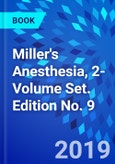Covering everything from historical and international perspectives to basic science and current clinical practice, Miller's Anesthesia, 9th Edition, remains the preeminent reference in the field. Dr. Michael Gropper leads a team of global experts who bring you the most up-to-date information available on the technical, scientific, and clinical issues you face each day - whether you're preparing for the boards, studying for recertification, or managing a challenging patient care situation in your practice.
- Contains fully revised and updated content throughout, including numerous new videos online.
- Includes four new chapters: Clinical Care in Extreme Environments: High Pressure, Immersion, and Hypo- and Hyperthermia; Immediate and Long-Term Complications; Clinical Research; and Interpreting the Medical Literature.
- Addresses timely topics such as neurotoxicity, palliation, and sleep/wake disorders.
- Streamlines several topics into single chapters with fresh perspectives from new authors, making the material more readable and actionable.
- Features the knowledge and expertise of former lead editor Dr. Ronald Miller, as well as new editor Dr. Kate Leslie of the University of Melbourne and Royal Melbourne Hospital.
- Provides state-of-the-art coverage of anesthetic drugs, guidelines for anesthetic practice and patient safety, new techniques, step-by-step instructions for patient management, the unique needs of pediatric patients, and much more - all highlighted by more than 1,500 full-color illustrations for enhanced visual clarity.
- Enhanced eBook version included with purchase. Your enhanced eBook allows you to access all of the text, figures, and references from the book on a variety of devices, in addition to accessing regular updates, related websites, and an expanded collection of procedural videos.
The initial printing of Miller's Anesthesia, 9e contained a dosage error in chapter 26, "Intravenous Drug Delivery Systems," on page 771, Table 26.5 (Manual Infusion Schemes). A maintenance infusion of Dexmedetomidine was mistakenly reported as 0.3 - 0.7 mcg/kg/min instead of 0.3 - 0.7 mcg/kg/hr (or 0.005-0.015 mcg/kg/min). As of October 2, 2020 all stock has been corrected. If you find that you have a book with this error please contact publisher for correction sticker.
Table of Contents
Section 1 INTRODUCTION 1. Scope of Modern Anesthetic Practice 2. The International Scope and Practice of Anesthesia 3. Perioperative Medicine 4. Informatics in Perioperative Medicine 5. Quality Improvement in Anesthesia Practice 6. Human Performance and Patient Safety 7. Patient Simulation 8. Ethical Aspects of Anesthesia Care
Section 2 ANESTHETIC PHYSIOLOGY 9. Consciousness, Memory, and Anesthesia 10. Sleep Medicine 11. Cerebral Physiology and the Effects of Anesthetic Drugs 12. Neuromuscular Physiology 13. Respiratory Physiology and Pathophysiology 14. Cardiac Physiology 15. Gastrointestinal Physiology and Pathophysiology 16. Hepatic Physiology and Pathophysiology 17. Renal Anatomy, Physiology, Pharmacology and Evaluation of Function 18. Basic Principles of Pharmacology 19. Inhaled Anesthetics: Mechanisms of Action 20. Inhaled Anesthetic Pharmacokinetics: Uptake, Distribution, Metabolism and Toxicity 21. Pulmonary Pharmacology and Inhaled Anesthetics��������������������������������� 22. Inhaled Anesthetics: Delivery Systems 23. Intravenous Anesthetics 24. Opioids 25. Nonopioid Pain Medications 26. Intravenous Drug Delivery Systems 27. Pharmacology of Neuromuscular Blocking Drugs 28. Reversal (Antagonism) of Neuromuscular Blockade 29. Local Anesthetics Section 3 ANESTHESIA MANAGEMENT 30. Risk of Anesthesia 31. Preoperative Evaluation 32. Anesthetic Implications of Concurrent Diseases 33. Complementary and Alternative Therapies���������������������������������������� 34. Patient Positioning for Anesthesia�������� 35. Neuromuscular Disorders and Other Genetic Disorders����������������������������� 36. Cardiovascular Monitoring 37. Perioperative Echocardiography 38. Implantable Cardiac Pulse Generators:� Pacemakers and Cardioverter-Defibrillators 39. Neurologic Monitoring 40. Monitoring Depth of Anesthesia (Monitoring Brain State) 41. Respiratory Monitoring 42. Renal Pathophysiology and Treatment for Perioperative Ischemia and Nephrotoxic Injury 43. Neuromuscular Monitoring 44. Airway Management in the Adult 45. Spinal, Epidural, and Caudal Anesthesia 46. Peripheral Nerve Blocks 47. Perioperative Fluid and Electrolyte Therapy����������������������������������������� 48. Perioperative Acid-Base Balance 49. Patient Blood Management: Transfusion Therapy 50. Patient Blood Management: Coagulation
Section 4 ADULT SUBSPECIALTY MANAGEMENT 51. Management of the Patient with Chronic Pain 52. Palliative Medicine 53. Anesthesia for Thoracic Surgery 54. Anesthesia for Cardiac Surgical Procedures���������������������������������������� 55. Anesthesia for Cardiac Catherization and Electroconversion 56. Anesthesia for Vascular Surgery 57. Anesthesia for Neurologic Surgery and Neurointerventions 58. Anesthesia for Bariatric Surgery 59. Anesthesia and the Renal and Genitourinary Systems 60. Anesthesia for Organ Transplantation 61. Anesthesia for Organ Procurement 62. Anesthesia for Obstetrics 63. Anesthesia for Fetal Surgery and Other Fetal Therapies 64. Anesthesia for Orthopaedic Surgery 65. Geriatric Anesthesia 66. Anesthesia for Trauma 67. Anesthesia in Prehospital and Emergency Care 68. Biologic, Natural and Human-induced Disasters: The Role of the Anesthesiologist 69. Anesthesia for Ophthalmic Surgery 70. Anesthesia for Otolaryngologic and Head-Neck Surgery�������������������������������������������� 71. Anesthesia for Robotic Surgery 72. Anesthesia for Ambulatory (Outpatient) Surgery 73. Non-Operating Room Anesthesia (NORA) 74. Clinical Care in Extreme Environments: At High and Low Pressure and in Space (AKA Hyperbaric) 75. Extreme Physiology
Section 5 PEDIATRIC ANESTHESIA 76. Regional Anesthesia in Children 77. Pediatric Anesthesia��������������������������� 78. Anesthesia for Pediatric Cardiac Surgery 79. Pediatric and Neonatal Intensive Care
Section 6 POSTOPERATIVE CARE 80. The Postanesthesia Care Unit������������ 81. Immediate and Long-Term Complications 82. Acute Postoperative Pain 83. Cognitive Dysfunction and Other Long-Term Complications of Surgery and Anesthesia
Section 7 CRITICAL CARE MEDICINE 84. Critical Care Anesthesiology����������� 85. Neurocritical Care 86. Extracorporeal Membrane Oxygenation and Cardiac Devices 87. Cardiopulmonary Resuscitation and Advanced Cardiac Life Support
Section 8 ANCILLARY RESPONSIBILITIES AND PROBLEMS 88. Electrical Burns and Other Burns 89. Environmental Safety and Chemical Dependency 90. Evidence and Clinical Trials 91. Interpreting the Medical Literature
Authors
Michael A. Gropper Associate Professor, Department of Anesthesia, Director, Critical Care Medicine, University of California, San Francisco, CA. Lars I. Eriksson Professor and Academic Chair, Department of Anaesthesiology and Intensive Care Medicine, Karolinska University Hospital, Solna. Lee A. Fleisher Lee A. Fleisher is the Robert Dunning Drips Professor and Chair of Anesthesiology and Critical Care Medicine at the Perelman School of Medicine at the University of Pennsylvania, Philadelphia, Pennsylvania, USA.. Jeanine P. Wiener-Kronish Anesthetist-in-Chief, Massachusetts General Hospital, Boston, Massachusetts. Neal H. Cohen Vice Dean, Affiliations and ComplianceProfessor Emeritus, Anesthesia and Perioperative Care and Medicine
UCSF School of Medicine
CA. Kate Leslie Staff Specialist, Head of Anesthesia Research, Royal Melbourne Hospital; Professor, Department of Anesthesiology, Monash University, Melbourne, Australia.








